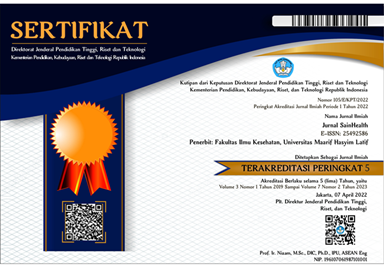HUBUNGAN GEJALA KLINIS DENGAN HASIL PEMERIKSAAN NON-STRUCTURAL PROTEIN (NS1) PASIEN SUSPEK DENGUE DI PUSKESMAS SUKODADI
RELATIONSHIP BETWEEN CLINICAL SYMPTOMS AND NON-STRUCTURAL PROTEIN (NS1) EXAMINATION OF DENGUE SUSPECTED PATIENTS AT SUKODADI HEALTH CENTER
Keywords:
clinical symptoms, non structural protein, NS1, dengueAbstract
Dengue fever is an endemic arbovirus disease that often causes morbidity and mortality. Rapid and appropriate treatment of dengue fever can be done if a rapid and specific test during the acute phase of infection can be done. An examination that has been developed is the dengue non-structural antigen (NS1) examination which can detect dengue virus infection earlier. The purpose of this study was to determine the relationship between clinical signs and symptoms with NS1 examination results in patients suspected of dengue fever at the Sukodadi Health Center. The type of research is descriptive analytical with a cross-sectional approach to 86 patients at the Sukodadi Health Center, Lamongan Regency using a simple random sampling technique. Data collection was carried out on patient medical records based on the results of clinical signs and symptoms of the examination and the results of the NS1 examination. The collected data were analyzed using the Chi-Square test, with a significance level of p <0.05. The results of the study showed that most patients (72.1%) were diagnosed with suspected dengue fever, most (79.1%) had negative NS1 examination results, and the Chi-Square test results obtained x count = 8.812, and p = 0.003 (<0.05), then H0 was rejected, meaning that there was a relationship between clinical signs and symptoms with NS1 examination results in patients with suspected dengue fever. The conclusion of this study is there is a significant relationship between clinical signs and symptoms with NS1 examination results in patients with suspected dengue fever
References
Chen, H. R., Lai, Y. C., & Yeh, T. M. (2018). Dengue virus non-structural protein 1: A pathogenic factor, therapeutic target, and vaccine candidate. Journal of Biomedical Science, 25(1), 1–11. https://doi.org/10.1186/s12929-018-0462-0
Da Costa, V. G., Marques-Silva, A. C., & Moreli, M. L. (2014). A meta-analysis of the diagnostic accuracy of two commercial NS1 antigen ELISA tests for early dengue virus detection. PLoS ONE, 9(4). https://doi.org/10.1371/journal.pone.0094655
Hasnidar, H., Tasnim, T., Sitorus, S., Hidayati, W., Mustar, M., Fhirawati, F., Yuliani, M., Marzuki, I., Yunianto, A. E., & Susilawaty, A. (2020). Ilmu Kesehatan Masyarakat. Yayasan Kita Menulis
Ismaillya Noor, R., Aryati, A., & Wardhani, P. (2018). Keterkaitan Antigen Ns1 Infeksi Virus Dengue Dengan Serotipe Virus Dengue. Indonesian Journal of Clinical Pathology and Medical Laboratory, 18(2), 87–91. https://doi.org/10.24293/ijcpml.v18i2.1005
Jawetz, M., & Adelberg. (2012). Mikrobiologi Kedokteran (25th ed.). EGC
Kularatne, S. A., & Dalugama, C. (2022). Dengue infection: Global importance, immunopathology and management. Clinical Medicine, Journal of the Royal College of Physicians of London, 22(1), 9–13. https://doi.org/10.7861/clinmed.2021-0791
Luvira, V., Thawornkuno, C., Lawpoolsri, S., Thippornchai, N., Duangdee, C., Ngamprasertchai, T., & Leaungwutiwong, P. (2023). Diagnostic Performance of Dengue NS1 and Antibodies by Serum Concentration Technique. Tropical Medicine and Infectious Disease, 8(2), 1–12. https://doi.org/10.3390/tropicalmed8020117
Mansur, R. A., & Yelly, H. (2023). Understanding Dengue: Exploring Epidemiology, Pathogenesis, and Management Penerbit Cv. Eureka Media Aksara.
Martínez-Cuellar, C., Lovera, D., Galeano, F., Gatti, L., & Arbo, A. (2020). Non-structural protein 1 (NS1) of dengue virus detection correlates with severity in primary but not in secondary dengue infection. Journal of Clinical Virology, 124(October 2019), 104259. https://doi.org/10.1016/j.jcv.2020.104259
Megariani, M., Mariko, R., Alkamar, A., & Putra, A. E. (2016). Uji Diagnostik Pemeriksaan Antigen Nonstruktural 1 untuk Deteksi Dini Infeksi Virus Dengue pada Anak. Sari Pediatri, 16(2), 121. https://doi.org/10.14238/sp16.2.2014.121-7
Muller, D. A., & Young, P. R. (2013). The flavivirus NS1 protein: Molecular and structural biology, immunology, role inpathogenesis and application asadiagnostic biomarker. Antiviral Research, 98(2), 192–208. https://doi.org/10.1016/j.antiviral.2013.03.008
Murray, N. E. A., Quam, M. B., & Wilder-Smith, A. (2013). Epidemiology of dengue: Past, present and future prospects. Clinical Epidemiology, 5(1), 299–309. https://doi.org/10.2147/CLEP.S34440
Prasetyo, E., Wahyudi, A., & Murni, N. (2023). Analisis Faktor Determinan yang Berhubungan Dengan Kejadian Demam Berdarah Dengue Di Wilayah Kerja Dinas Kesehatan. Jurnal ’Aisyiyah Palembang, 8(1), 36–40.
Senthilraja, M. (2013). Drug fever-an overview. Pharma Times, 45(2), 16–27.
Shepard, D. S., Coudeville, L., Halasa, Y. A., Zambrano, B., & Dayan, G. H. (2011). Economic impact of dengue illness in the Americas. American Journal of Tropical Medicine and Hygiene, 84(2), 200–207. https://doi.org/10.4269/ajtmh.2011.10-0503
Wowor, M. F. (2013). Deteksi Dini Demam Berdarah Dengue Dengan Pemeriksaan Antigen Ns1. Jurnal Biomedik (Jbm), 3(1), 1–9. https://doi.org/10.35790/jbm.3.1.2011.853
Downloads
Published
Issue
Section
License
Copyright (c) 2024 Jurnal SainHealth

This work is licensed under a Creative Commons Attribution 4.0 International License.
Jurnal SainHealth is licensed under Creative Commons Attribution 4.0 International License.
Under the following terms:
Attribution — You must give appropriate credit, provide a link to the license, and indicate if changes were made. You may do so in any reasonable manner, but not in any way that suggests the licensor endorses you or your use.
No additional restrictions — You may not apply legal terms or technological measures that legally restrict others from doing anything the license permits.
















